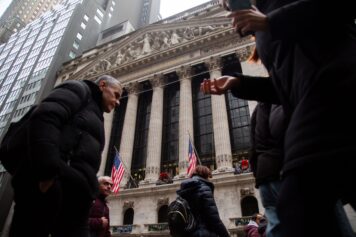By Stephen Kirkland and Vildana Hajric
U.S. stocks fell for a second day in a row as risk sentiment deteriorated after Ukraine’s top diplomat said he didn’t see the progress in Russian-Ukrainian talks.

Comments by Ukrainian Foreign Minister Dmytro Kuleba came after IFX cited Russian President Vladimir Putin as underscoring daily efforts to resolve tensions, news that helped bolster risk appetite in early U.S. trading. Meanwhile, U.S. President Joe Biden on Friday called on U.S. lawmakers to join Western allies to end normal trade relations with Russia.
The S&P 500 briefly pared losses before turning back toward the day’s lows. The tech-heavy Nasdaq 100 bore the brunt of the risk-off sentiment, dropping 1%. The dollar rose amid a pickup in haven demand.
“We’re in a headline-driven market and headline-driven markets happen during periods of uncertainty,” Keith Lerner, co-chief investment officer and chief market strategist at Truist Advisory Services, said by phone. “We always have uncertainty, but when you have higher-than-normal uncertainty, each headline tends to get over-extrapolated in both directions. I think that’s what we’re seeing.”
Global markets have been on edge this week as the worsening war in Ukraine and sanctions against Russia stoke inflation fears and threaten to sap growth. Markets have lurched between panic-selling and dip-buying of beaten-down stocks that pushed S&P 500 to the biggest daily losses and gains since 2020. Volatility wasn’t limit to equity markets, with oil in New York swinging in an arc from above $130 a barrel to as low as almost $103. Bonds too gyrated, with 10-year Treasury yield climbing from below 1.7% to above 2%.
Those wild swings came in a week that saw inflation in February accelerating at the fastest pace in 40 years in February, reinforcing expectations that the Federal Reserve next week will start raising interest rates to contain inflation that some economists see rising above 8%. If the European Central Bank’s decisions Thursday are any guide, policy makers may prioritize their inflation fight over the need to support economic recovery.
“Fundamentals are taking a back seat to the Fed, which is taking a backseat right now to what’s going on in Ukraine, Tom Hainlin, national investment strategist at U.S. Bank National Association, said by phone. The Fed meeting is “going to be a material event — anticipating that the Fed’s going to finally pivot to the beginning of tightening policy.”
Bond traders ramped up inflation projections Friday after a manic week of commodity-price rises with the 30-year security at the highest since 2013. At 2.59%, the long-dated breakeven — the market’s forecast for price growth over the next three decades — is joining short-term maturities at historically elevated levels.
U.S. consumer sentiment tumbled in early March to the lowest since 2011 and year-ahead inflation expectations rose to a four-decade high in the aftermath of Russia’s invasion of Ukraine, according to a University of Michigan’s sentiment index.
Some of the main moves in markets:
Stocks
- The S&P 500 fell 0.4% as of 1:59 p.m. New York time
- The Nasdaq 100 fell 1%
- The Dow Jones Industrial Average was little changed
- The MSCI World index fell 0.7%
Currencies
- The Bloomberg Dollar Spot Index rose 0.5%
- The euro fell 0.8% to $1.0903
- The British pound fell 0.4% to $1.3038
- The Japanese yen fell 1% to 117.25 per dollar
Bonds
- The yield on 10-year Treasuries was little changed at 2.00%
- Germany’s 10-year yield declined two basis points to 0.25%
- Britain’s 10-year yield declined three basis points to 1.49%
Commodities
- West Texas Intermediate crude rose 2.7% to $108.84 a barrel
- Gold futures fell 0.7% to $1,987 an ounce
More stories like this are available on bloomberg.com




